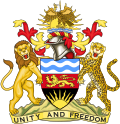| Queen of Malawi | |
|---|---|
 | |
 | |
| Details | |
| Style | Her Majesty |
| Formation | 6 July 1964 |
| Abolition | 6 July 1966 |
Elizabeth II was Queen of Malawi from 1964 to 1966, when Malawi was an independent sovereign state and a constitutional monarchy within the Commonwealth of Nations. She was also the sovereign of the other Commonwealth realms, including the United Kingdom. The 1964 Constitution of Malawi vested executive power in the monarch as head of state, though her constitutional roles were delegated to her representative, the Governor-General, Sir Glyn Smallwood Jones, who was also the last Governor of Nyasaland. [1]



